|
|
|
|
|
WE
PROUDLY SUPPORT FALLINGWATER
AND THE WESTERN
PENNSYLVANIA CONSERVANCY
 |
|
|
|
|
BITTER ROOT INN, NEAR STEVENSVILLE, MONTANA (1908 -
S.145) |
|
|
|
This past summer my wife and I
had the opportunity to travel through Montana, so she
graciously allowed me a detour through the beautiful
Bitterroot Valley in the Southwestern corner of Montana,
just a few miles South of Missoula. The goal was two fold.
To locate the original site of the Bitter Root Inn, and to
document the two remaining buildings designed by Wright in
the Como Orchard Summer Colony, University Heights (S.144)
in Darby. They were two separate projects, financed by the
same company, the Bitter Root Valley Irrigation Company, but
are physically over forty miles apart. These two, along with
the Lockridge Medical Clinic in
Whitefish (S.425) (1958) make up the three Wright
projects in Montana.
In preparation for our trip I
contacted John Stroud, an author and local historian, born,
raised and living in the Stevensville area of the Bitterroot
Valley. I met John in town at the local Drug Store,
purchased his book and had the opportunity to spend time
getting acquainted with the area, stopping to see the
historic St. Mary’s Mission and listening to some of the
local stories, then headed out to locate the site of the
Bitter Root Inn.
Unlike the "cold inhospitable
place" discovered by Lewis and Clark in September 1805, I
found the Bitterroot valley beautiful and inviting, actually
commenting to my wife that this would be a beautiful place
to retire. Norman Maclean’s "A River Runs Through It" was
written about life during the early twentieth century in
Missoula, on the Northern end of the Bitterroot Mountains.
Stevensville was the first
permanent settlement in the state of Montana. It was settled
by Jesuit Missionaries at the request of the Bitter Root
Salish Indians. Through their interactions with the Iroquois
between 1812 and 1820, the Salish leaned about Christianity
and the Jesuits that worked with Indian tribes teaching them
agriculture, medicine, and religion. In 1831, four young
Salish men were dispatched to St. Louis to request a "blackrobe".
They were directed to William Clark (Lewis and Clark). At
that time Clark administered their territory. During their
trip two of the Indians died at the home of General Clark.
The remaining two met with Bishop Rosati who assured them
that missionaries would be sent when funds and missionaries
were available. In 1835 and 1837 the Salish dispatched men
again. Finally in 1839 a group of Iroquois and Salish met
Father DeSmet in Council Bluff, IA. He promised to fulfill
their request the following year. He finally arrived two
years later in Stevensville on September 24, 1841 and called
the settlement St. Mary’s. He immediately built a chapel,
then log cabins and Montana’s first pharmacy. In 1850 Major
John Owen arrived in the valley and set up camp north of St.
Mary’s. He established a trading post and military strong
point named Fort Owen, which served the settlers, Indians,
and missionaries in the valley. In 1853 territorial
Governor
Isaac Ingalls Stevens spent time surveying the area as he
slowly moved west following the Lewis & Clark’s trail. He was
called back to active duty with the Union Army. He was
killed in action in 1862 at Chantilly. In 1864 St. Mary's
was changed to Stevensville in his honor.
In 1887 Marcus Daly, one of
Montana’s "Copper Kings" came to the Bitterroot valley in
search of timber for his Butte mines. He built a mill and
formed the town of Hamilton. He built a beautiful summer
home in 1887 and accumulated over 22,000 acres for timber
and for his hobby of breeding and racing thoroughbred
horses. He named his ranch the Bitter Root Stock Farm. By
1888 over one million board feet of lumber was milled every
week in the Bitterroot valley. The town of Hamilton which
was along the route of the Northern Pacific Railway, was
incorporated in 1894. Calamity Jane even opened a cafe on
Main Street in 1896. By the time Daly passed away in 1900,
Hamilton was the commercial center of the Bitterroot Valley
and the seat of Ravalli County.
One of Daly’s projects was a
canal and ditch system for irrigating his land. It was
abandoned after his death. In 1905 Samuel Dinsmore continued
the concept and started developing the "Big Ditch", an 80
mile irrigation project from Lake Como (just |
|
Northwest of Darby) to Florence,
just north of Stevensville. After running into
financial difficulty, it was reorganized with the help of
Chicago financiers W. I. Moody, Frederick D. Nichols (1906 -
S.118) and others and renamed the Bitterroot District
Irrigation Co. By 1904 Moody was General Manager of the
Muncie Works, producing Iron and Steel as well as
operating Natural Gas Wells. Their offices were in the
Rookery Building in Chicago. Wright remodeled the Rookery in
1905 (S.113). Moody visited the Bitterroot Valley in 1905.
By 1907 they had purchased and sub-divided large sections of
the valley into 10 acre parcels for fruit orchard
development. They paid $2.50-$15 per acre and resold "apple
orchard tracts" at $400-$1,000 per acre. The company quickly
became rich.
By 1909 three rail lines ran
to Missoula, Montana, with a connecting spur to the
Bitterroot Valley. Land, transportation and water. A perfect
combination. Most likely because of Nichols’ relationship
with Wright and Moody’s knowledge of Wright, he was hired to
design two developments. Como Orchard Summer Colony (S.144)
and the Town of Bitter Root. In February 1909 Wright, Moody
and Nichols visited the valley (FLWNL). Wright's first
site plan for the Town of Bitter Root was rejected. His
second proposal was a scaled down version which he called
the Village of Bitter Root which included the Bitter Root
Inn, the only structure built in the Village. It opened in October of 1909. Sales was aimed at
the wealthy. The "apple boom" was on. Investors from the
east were wined and dined. They were given free rail passage
and transportation where they were lavishly entertained at
the Bitter Root Inn. Lodging, dinner and golf were free. So
was the French wine.
There were many classic Prairie styled Wright details in the
Bitter Root Inn, a paradise in the wilderness. The basic
material was wood, using board and batten siding and
shingles for the roof. Strong horizontal lines, low-pitched
roof, broad overhanging eaves, horizontal rows of leaded or
mullion divided glass windows and glass doors, two prominent
centrally located fireplaces and chimneys, balconies and
porches. The Dining and Reception Rooms were designed with
large semicircular fireplaces. There are built-in piers or
columns that could have been designed for planters or large
vases like many of his buildings at that time. The drawings
for the unbuilt Office in Bitter Root did include large
vases. The Inn was 126 feet long and two stories tall. The
first floor included a Dining Room on the north, an office
in the center, a Reception Room on the South, and a
large Porch on either end. The wing behind the center office
included a kitchen and two additional bedrooms. An open
gallery ran the length of the front of the building. The
second floor included 20 Bedrooms, Men’s and Women’s Baths
in center and Balconies on either end. Running water and
electricity included.
The boom was short lived.
Blight destroyed much of the valley’s crop in 1913. Law
suits plagued the company. They filed for bankruptcy in
1916. It ceased as an inn, but was used as a dance hall and
roadhouse. Finally on July 26, 1924, fire destroyed the
Bitter Root Inn.
Wright’s second site plan for
the Village of Bitter Root, which included the Inn, also
include typographical markings. When matching those to
existing maps, Porter Hill Road now runs through the North
end of the site of the Bitter Root Inn. Little remains of
the "dreams" of Bitter Root, Montana one day overtaking
Missoula in size and importance. A cursory glance would
reveal little of the few remnants of the original concrete
foundation. The original Northwest corner property marker
exists, though it can’t be confirmed it wasn’t moved over
the years. About 150 yards to the North a single fire
hydrant is all that remains of the town’s water system and
power plant installed one hundred years ago. Dreams change,
memories fade, time passes, life goes one. But if not for
the dreams of Moody, Nichols and Wright, the Bitter Root Inn
would never have been conceived and built.
Text by
Douglas M. Steiner, Copyright September 2009.
|
|
|
|
|
Fort
Owen 1853 Isaac
Ingalls Stevens
Rookery Building Locating
Bitter Root Inn Site
Site Plan for the
Town of Bitter Root
Site Plan for the Village of Bitter Root
Birds-eye View of Bitter Root Village
Original Floor Plan
Bitter Root Inn Circa 1910
Bitter Root Inn Circa 1915
View From Bitter Root Circa 1915
Photographs of the Site of the Original Bitter Root Inn
Books & Articles
Additional Wright Studies |
|
|
|
|
|
Fort Owen, Bitterroot Valley, Montana, September
1853 |
| |
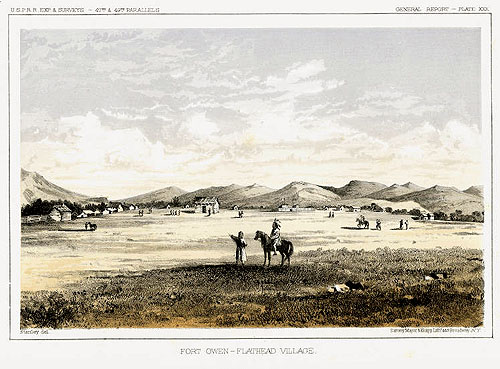 |
Fort Owen - Flathead Village. U.S.P.R.R. Exp. &
Surveys - 47th & 49th Parallels. General Report -
Plate XXX. Stanley, Del. Sarony Major & Knapp Liths.
449 Broadway, N.Y.
The Stevens expedition, following the Lewis & Clark
Trail, arrived at Fort Owens on September 28, 1853.
Territorial Governor Isaac Ingle Stevens wrote: "I
would earnestly urge all persons desirous to know
the minute details of the topography of this valley
to study carefully the narrative of Lewis and Clark;
for to us it was a matter of the greatest
gratification, with their narrative in hand, to pass
through this valley and realize the fidelity and the
graphic character of their descriptions." Published
in "Reports of Explorations and Surveys to Ascertain
the Most Practicable and Economical Route for a
Railroad from the Mississippi River to the Pacific
Ocean." Made under the direction of the Secretary of
War in 1853-5. Volume XII, Book I. Washington: Thomas H.
Ford, Printer 1860. Illustrated by John Mix Stanley. |
| |
| |
| |
|
Isaac Ingalls Stevens |
| |
|
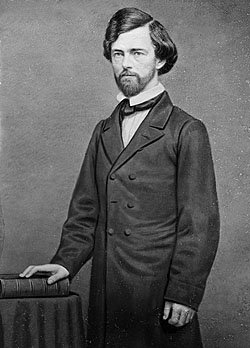 |
|
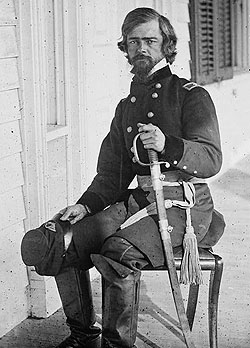 |
|
Honorable Isaac
Ingalls Stevens. First Governor of he newly
created Washington Territory which included
Washington, Idaho, parts of Montana and
Nebraska.
Circa 1855-1860. Courtesy Library of
Congress. |
|
General Isaac
Ingalls Stevens.
Photographed March 1862 in Beaufort, S.C. by
Timothy H. O'Sullivan shortly before his
death. Courtesy Library of Congress. |
|
|
|
|
|
|
|
|
Rookery Building 1905 (S.113) |
|
|
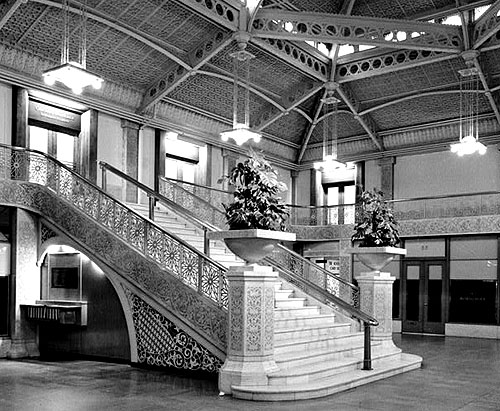 |
|
By 1904, W. I. Moody
was General Manager of the
Muncie Works, producing Iron and Steel as well as
operating Natural Gas Wells. Their offices were in
the Rookery Building in Chicago. Wright remodeled
the Rookery in 1905 (S.113). |
|
|
|
|
|
|
|
Locating
Bitter Root Inn Site |
|
|
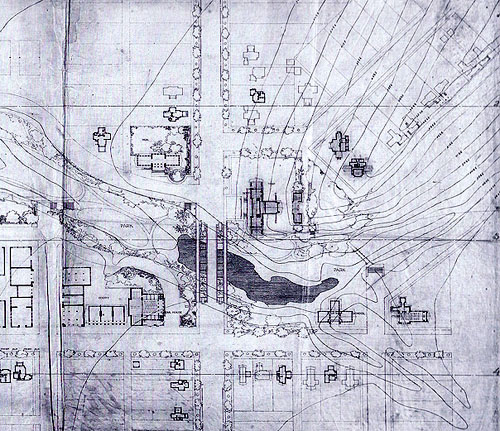 |
|
Detail of the Site
plan laid out in 1909 by Frank Lloyd Wright, which
included topographic measurements. Courtesy of The
Frank Lloyd Wright Foundation. |
|
|
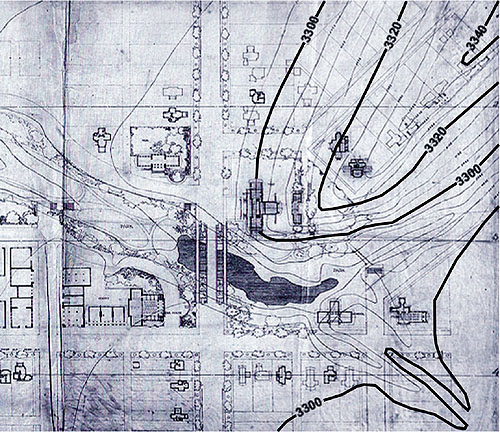 |
|
Detail of the Site
plan laid out in 1909 by Frank Lloyd Wright, with
enhanced topographic labeling added by Douglas
Steiner. |
|
|
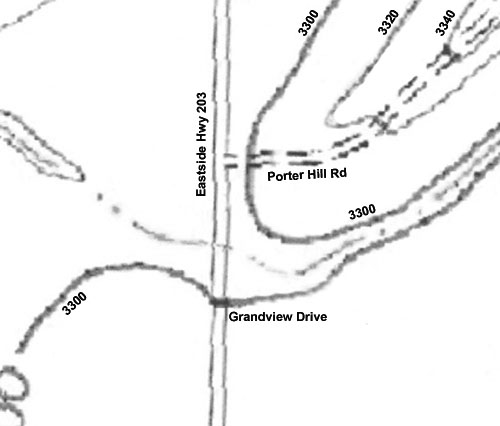 |
|
Detail of the USGS
topographic map 2009. Enhanced
topographic labeling added by Douglas Steiner.
John Stroud indicated that some excavation has taken
place on the hillside over the years. Courtesy of
the USGS. |
|
|
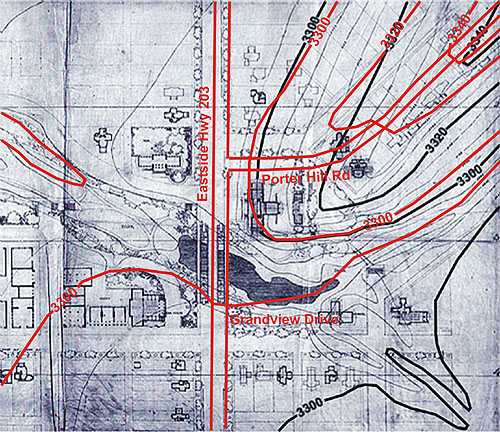 |
|
Detail of the Site
plan laid out in 1909 by Frank Lloyd Wright,
overlaid with
2009 topographic map (red).
John Stroud indicated
that some excavation has taken place, which may
account for variations between 1909 and 2009, but
give a clear indication as to where the Inn was
located. |
|
|
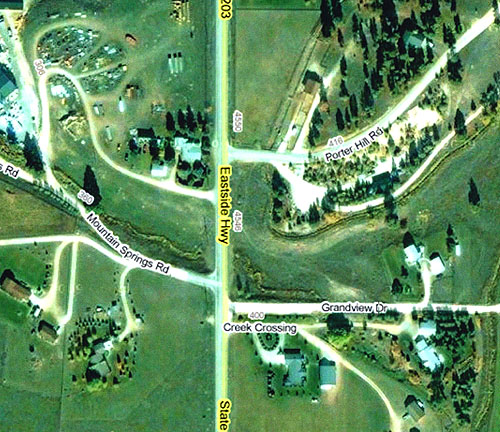 |
|
Aerial view of the
site in
2009.
Courtesy of
DigitalGlobe, GeoEye. |
|
|
|
|
|
|
|
|
|
Site Plan for the Town of Bitter Root |
|
|
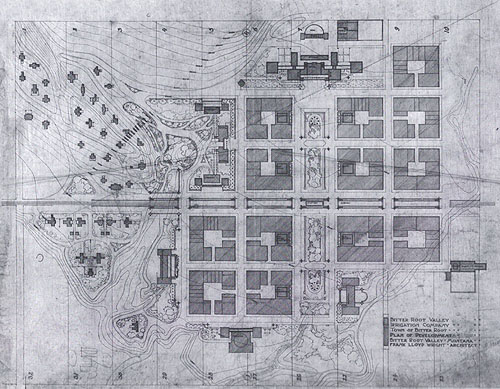 |
|
Wright's first site
plan for the Town of Bitter Root included a Hotel, top center,
with a planted pedestrian boulevard that ran
westerly from the hotel through the middle of town.
Running North and South through the middle of town
was the rail line which Wright envisioned as a
Subway, with a station in the center. Wright
included a School and Library, top left corner of
town, the Administration Offices lower left of town
and a Theater, bottom center. The Hospital was just
to the right, and the Light and Power Company was on
the far right. The buildings in town were designed
with open center courts. The Fire Department,
Telegraph Office and other services were dispersed
in these buildings throughout the town. This first
site plan for the Town of Bitter Root was rejected
and Wright proposal s a scaled down version he
called the Village of Bitter Root. Courtesy of The Frank Lloyd
Wright Foundation. |
|
|
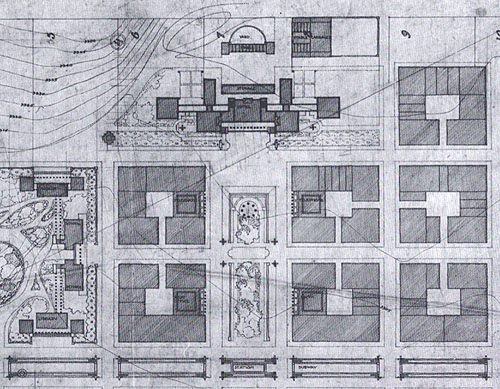 |
|
This detail includes
the Hotel, top center, with a planted pedestrian
boulevard that ran westerly from the hotel through
the middle of town. Running North and South through
the middle of town was the rail line which Wright
envisioned as a Subway, with a station in the
center. Wright included a School and Library, seen
on the left. The buildings in town were designed
with open center courts. The Fire Department,
Telegraph Office and other services were dispersed
in these buildings throughout the town. |
|
|
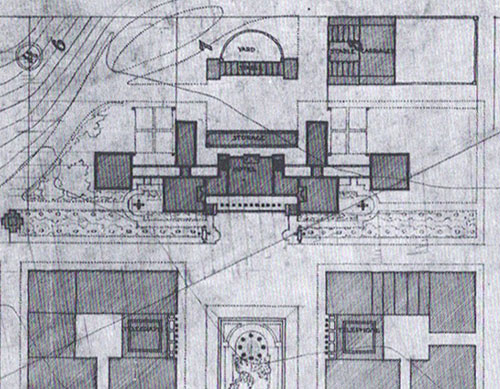 |
|
The Hotel Wright
proposed for the Town of Bitter Root was much larger
than the Inn that was finally realized. It was
extensively landscaped, and included storage,
stables and a garage for carriages. |
|
|
|
|
|
|
|
Site Plan for the Village of Bitter Root |
|
|
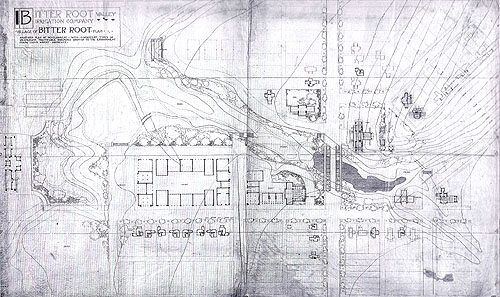 |
|
Wright's first site plan for the Town of Bitter Root
was rejected. His second proposal was a scaled down
version which he called the Village of Bitter Root.
It included a Train Station on the left, Market
Buildings with an open Court in the center, an Opera
House and across the stream and ravine on the right,
the Bitter Root Inn. The Inn was the only structure
built in the Village. Courtesy of The Frank Lloyd
Wright Foundation. |
| |
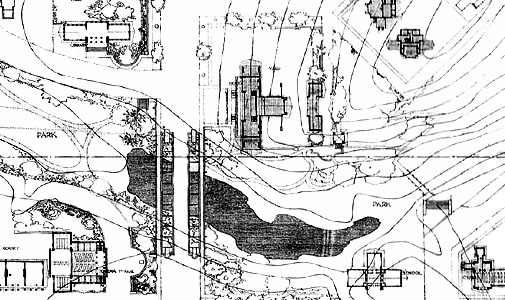 |
|
Detail of Wright's second site plan for the Village
of Bitter Root. It included a Library at the top
left, a Park in the center left in the Ravine and
the Opera House at the bottom left. The Bridge is in
the center. Note the interesting design. The
Bitter Root Inn (Hotel) is in the center. At the
bottom right, a School is the second building from
the right and a Church on the far right. |
| |
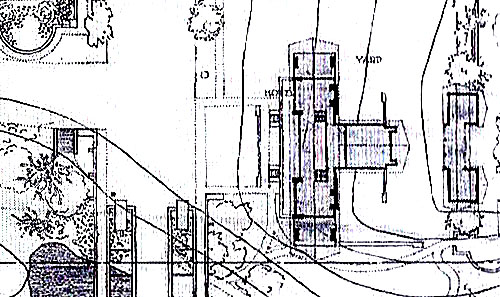 |
|
Detail of Wright's second site plan for the Village
of Bitter Root. The Bitter Root Inn, labeled Hotel,
is in the center. |
| |
| |
| |
|
Birds-eye View of the Village of Bitter Root |
| |
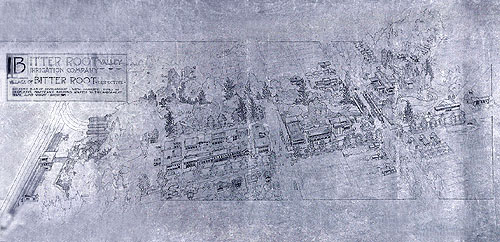 |
|
Birds-eye view of
Wright's proposal plan for the Village of Bitter Root.
It included a Train Station on the left, Market
Buildings with an open Court in the center, an Opera
House and across the stream and ravine on the right,
the Bitter Root Inn. The Inn was the only structure
built in the Village. Courtesy of The Frank Lloyd
Wright Foundation. |
| |
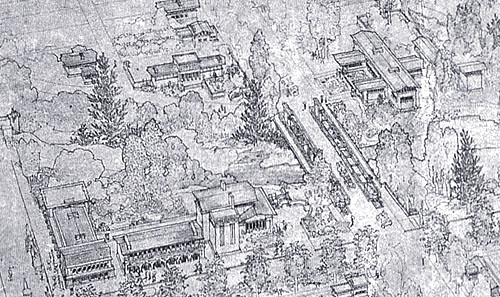 |
|
Detail of the Birds-eye view for the Village
of Bitter Root. It included a Library left of
center, near the top
left, and
the Opera House at the bottom center, the taller
building. The Bridge is in
the center. Note the interesting design. The
Bitter Root Inn is near the top right. |
| |
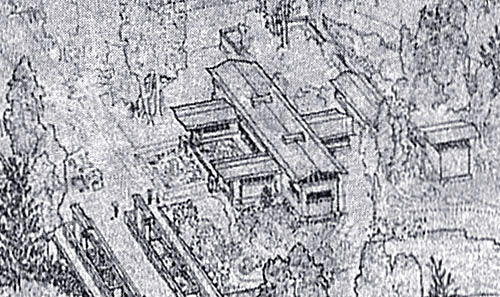 |
|
Detail of the Birds-eye view for the Bitter Root Inn.
Drawing of the Inn show that the two wings off he
front of the Inn were erased, indicating that he
intended to include them in the first designed.
They could have been removed to cut costs. |
| |
| |
|
|
|
|
Original Floor Plan |
| |
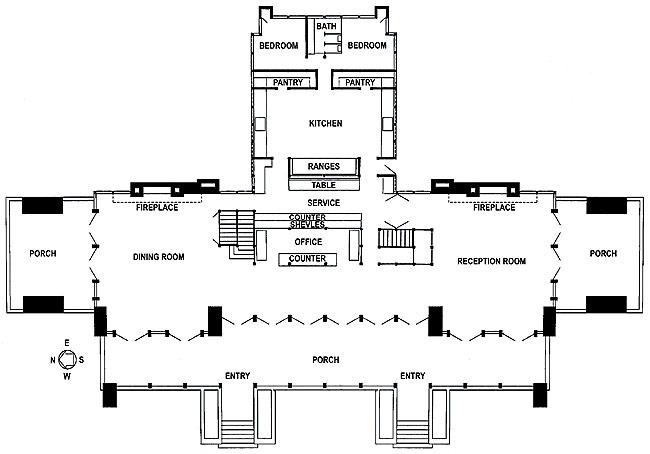 |
| The Inn
was 126 feet long, two stories tall and built on a 3.5 foot
grid. The first floor included a Dining Room on the north,
an office in the center, a Reception Room on the South and a
large Porch on either end. The wing behind the center office
included a kitchen and two additional bedrooms. A open
gallery ran the length of the front of the building. The
second floor included 20 Bedrooms, Men’s and Women’s Baths
in center and Balconies on either end. Running water and
electricity included. |
| |
 |
| The second
floor was 120 feet long and included 20 Bedrooms. The Men’s
and Women’s Baths were in center and Balconies on either end
and one that ran partially across the front. Running water
and electricity were included. Planter boxes were in the
front, to the left and right side of the balcony. |
| |
| Original
floor plan copyright 1993, “The
Frank Lloyd Wright Companion” Storrer, William Allin,
page 148.
Modified by Douglas M. Steiner, copyright 2009. |
| |
| |
| |
|
Bitter Root Inn, Circa 1910 |
|
|
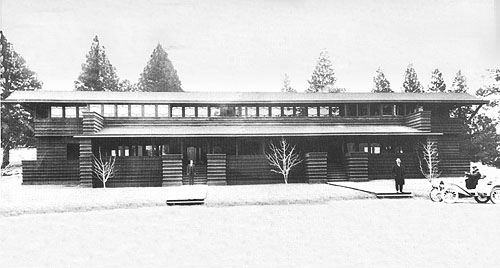 |
| There were
many classic Prairie styled Wright details in the Bitter
Root Inn, a paradise in the wilderness. The basic material
was wood, using board and batten siding and shingles for the
roof. Strong horizontal lines, low-pitched roof, broad
overhanging eaves, horizontal rows of leaded or mullion
divided glass windows and glass doors, two prominent
centrally located fireplaces and chimneys, balconies and
porches. The Dining and Reception Rooms were designed with
large semicircular fireplaces. There are built-in piers or
columns that could have been designed for planters or large
vases like many of his buildings at that time. The drawings
for the unbuilt Office in Bitter Root did include large
vases. The Inn was 126 feet long and two stories tall. The
first floor included a Dining Room on the left, an office in
the center, a Reception Room on the right, and a large Porch
on either end. An open gallery ran the length of the front
of the building. The second floor included 20 Bedrooms,
Men’s and Women’s Baths, and a Balcony that runs along the
front and one on either end. Running water and electricity
included. |
| |
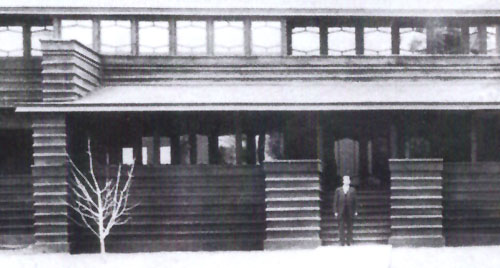 |
| Detail
shows many of the Wright details in the Bitter Root Inn:
Board and batten siding; Rows of leaded or mullion divided
glass windows and glass doors. The person standing in front
of the stairs shows the size relationship of the pedestals
on either side of the stairs. |
| |
| |
|
|
|
Bitter Root Inn,
Circa 1915 |
|
|
 |
| The Porch
has been enclosed on the end of the first floor. A fence has
enclosed the yard, flowers planted and plants added to the
pedestals on either side of the stairs. Original fireplug
can be seen on the left, just to the right of the pole on
the left. |
| |
| |
|
|
|
View from the Bitter Root Inn,
Postcard Circa 1915 |
|
|
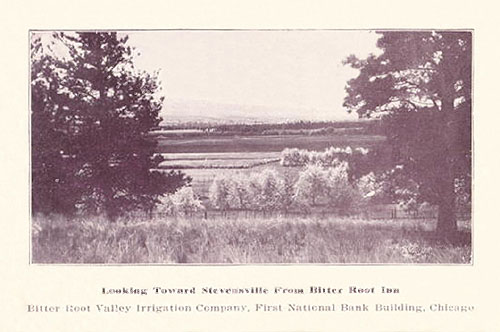 |
| "Looking
Toward Stevensville From Bitter Root Inn. Bitter Root Valley
Irrigation Company, First National Bank Building, Chicago." |
| |
| |
|
|
|
|
|
|
Photographs
of the Original Site for the Bitter Root Inn,
September 2009 |
|
|
One of the goals of our detour
through the beautiful Bitterroot Valley this past summer was
to locate the original site of the Bitter Root Inn. In preparation for our trip I
contacted John Stroud, an author and local historian, born,
raised and living in the Stevensville area of the Bitterroot
Valley. I met John in town at the local Drug Store,
purchased his book and had the opportunity to spend time
getting acquainted with the area, stopping to see the
historic St. Mary’s Mission and listening to some of the
local stories, then headed out to locate the site of the
Bitter Root Inn.
Unlike the "cold inhospitable
place" discovered by Lewis and Clark in September 1805,
just a little over two hundred years, I
found the Bitterroot valley beautiful and inviting, actually
commenting to my wife that this would be a beautiful place
to retire. Norman Maclean’s "A River Runs Through It" was
written about life during the early twentieth century in
Missoula, on the Northern end of the Bitterroot Mountains.
When we arrived we parked on
Grandview Drive, at the South end of the ravine. Where
Wright proposed a bridge, dirt and blacktop sit. A small
stream stills meanders along the floor of the ravine, and
Wright pictured a small pond and park for the |
|
community. We decided to head North first,
before examining the site. Little remains of the "dreams" of
the Village of Bitter Root, Montana one day overtaking
Missoula in size and
importance. A cursory glance as we walked North along
Eastside Highway reveal little of the few remnants of the
original concrete foundation. One neighbor we spoke to, who
had lived there for years was unaware this was the site of
the original Bitter Root Inn. About 150 yards to the North
of Porter Hill Road, a single fire hydrant is all that
remains of the town’s water system and power plant installed
one hundred years ago.
We headed back toward the
site and John pointed out an original historic corner
property marker located on the Northeast corner of Porter
Hill Road and Eastside Highway. Whether this is the
original Northwest corner marker for the site of the Bitter
Root Inn, can only be confirmed with more research. Large
sections of concrete remain on the site. Possibly footings
for the fireplace. Dreams change, memories fade,
time passes, life goes one. But if not for the dreams of
Moody, Nichols and Wright, the Bitter Root Inn would never
have been conceived and built. |
|
|
|
|
|
|
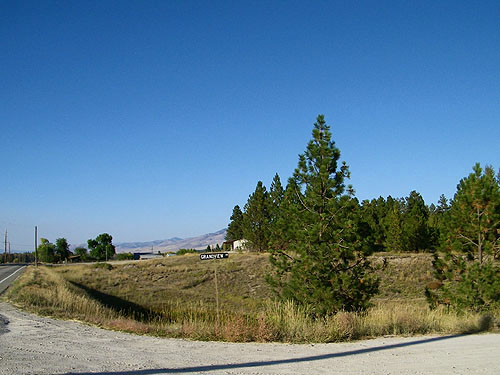 |
|
1: Viewed from the South
looking past the ravine. When we arrived we parked on
Grandview Drive, at the South end of the ravine. Where
Wright proposed a bridge, dirt and blacktop sit. A small
stream stills meanders along the floor of the ravine. Wright
pictured a small pond on the East side of the bridge and
community park in the ravine on the West side. We decided to
head North first, before examining the site. |
|
|
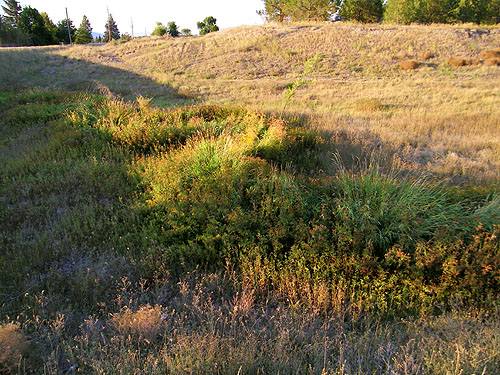 |
|
2: Viewed from the South
looking into the ravine. A small stream stills meanders
along the floor of the ravine. Wright pictured a small pond
here on the East side of the bridge. |
|
|
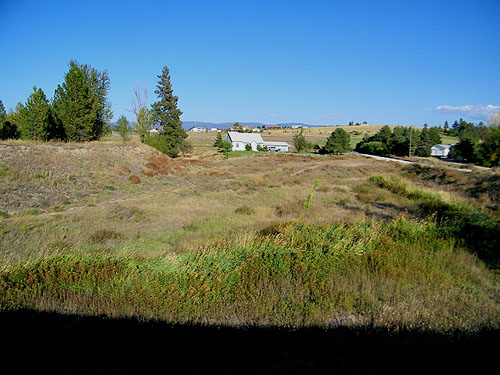 |
|
3: Viewed from the West
looking into the ravine from where Wright envisioned a
bridge. A small stream stills meanders along the floor of
the ravine. Wright pictured a small pond here on the East
side of the bridge |
|
|
|
|
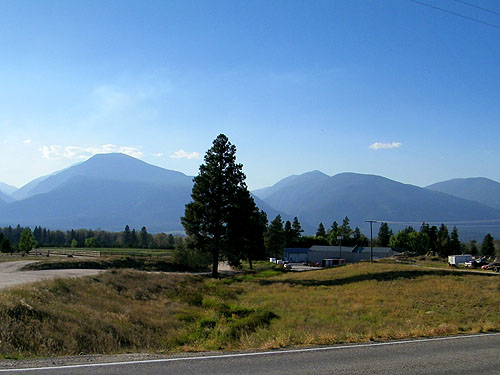 |
|
4: Viewed from the East
looking into the ravine from where Wright envisioned a
bridge. A small stream stills meanders along the floor of
the ravine. Wright pictured a community park in the ravine
on this west side of the bridge. |
|
|
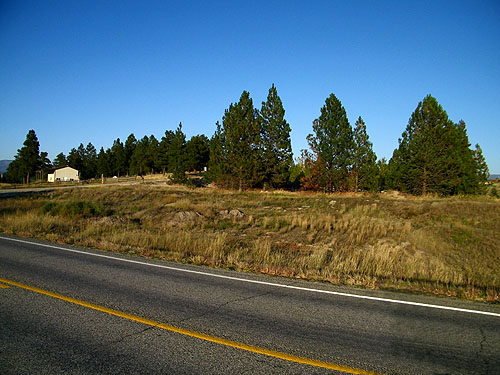 |
|
5: View of the site from the
Southwest. Little remains of the "dreams" of the Village of
Bitter Root Inn. A cursory glance as we walked North along
Eastside Highway reveal little of the few remnants of the
original concrete foundation. One neighbor we spoke to, who
had lived there for years was unaware this was the site of
the original Bitter Root Inn. |
|
|
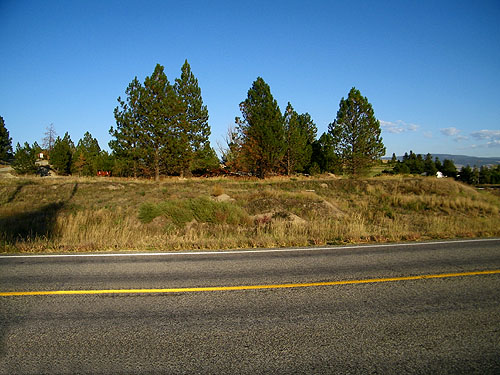 |
|
6: View of the site from the
West. A cursory glance as we walked North along
Eastside Highway reveal little of the few remnants of the
original concrete foundation. Approximate position of where
the next photograph (6b)was take around 1910. |
|
|
 |
|
6b: Bitter Root Inn circa
1910. |
|
|
 |
|
7: View of the site from the
Northwest. Approximate position of where the next photograph
(7b) was take around 1915. |
|
|
|
 |
|
7b: Bitter Root Inn circa
1910. |
|
|
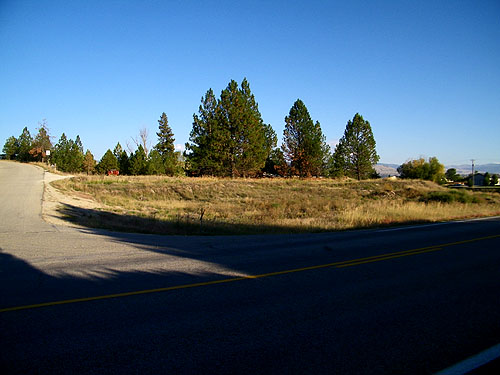 |
| 8:
View of the site from the Northwest. Porter Hill Road is on
the left. |
| |
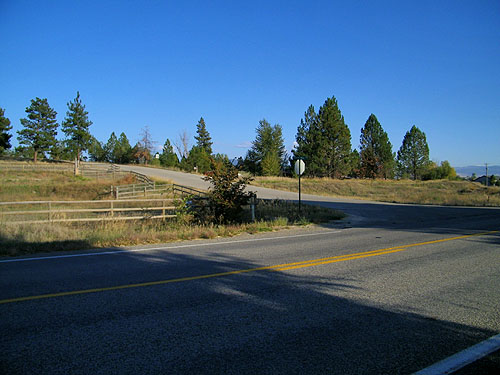 |
| 9: View of
the site as we headed North of Porter Hill Road, toward the
fire hydrant that remains from the town’s water system and
power plant installed one hundred years ago. |
| |
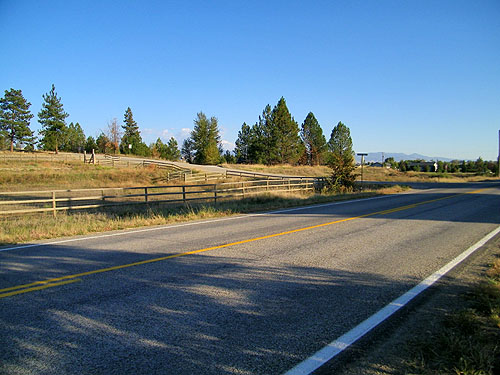 |
| 10:
View of the site from the North. |
| |
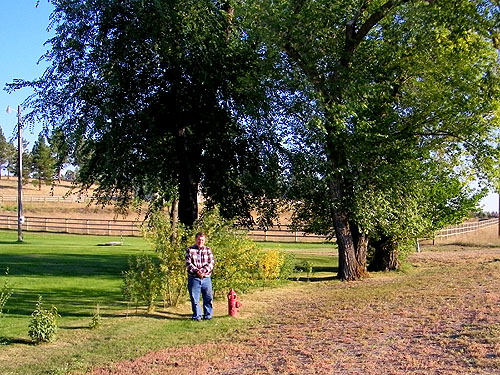 |
| 11: John
Stroud located the fire hydrant that is a remnant of the
town’s water system and power plant installed one hundred
years ago. |
| |
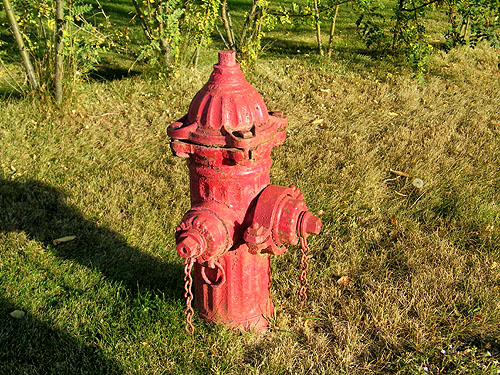 |
| 12: About
150 yards to the North of Porter Hill Road, a single fire
hydrant is all that remains of the town’s water system and
power plant installed one hundred years ago. |
| |
 |
| 13: We
headed back toward the site and John pointed out an original
historic corner property marker located on the Northeast
corner of Porter Hill Road and Eastside Highway just in
front of the large concrete block. |
| |
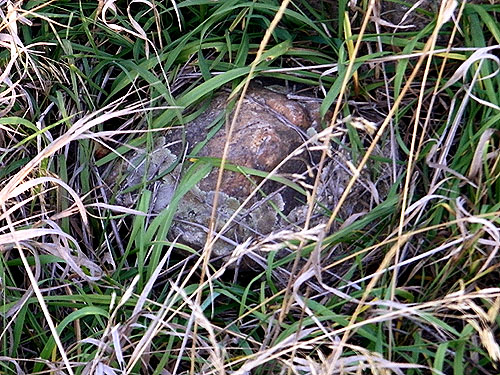 |
| 14: The
original historic corner property marker is located just in
front of the large concrete block. Whether this is the
original Northwest corner marker for the site of the Bitter
Root Inn, can only be confirmed with more research. |
| |
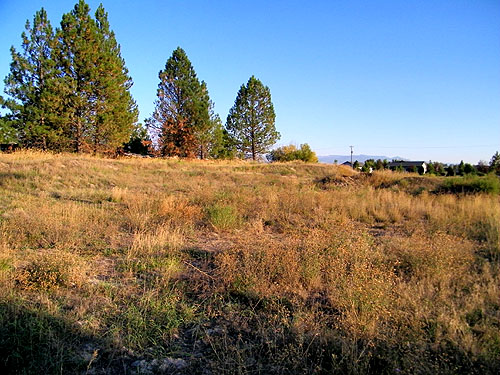 |
| 15: A
cursory glance of the site reveal little of the few remnants
of the original concrete foundation. Just below the tree
line we located large sections of concrete. Possibly
footings for the fireplace. |
| |
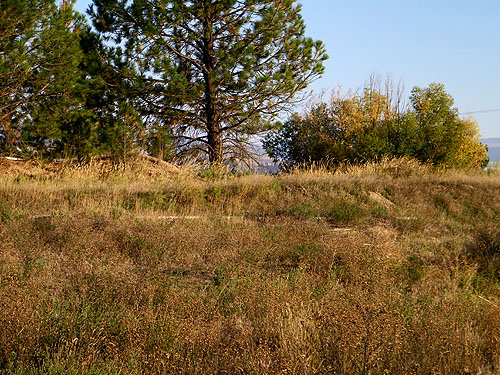 |
| 16: Just
below the tree line there are large sections of concrete.
Possibly footings for the fireplace. |
| |
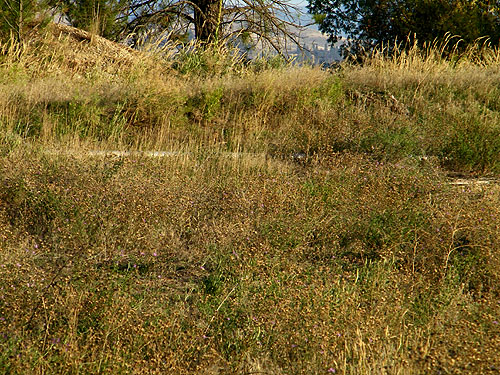 |
| 17: The
large sections of concrete are just in front of the long
plastic pipe and the 2x4 on the right. |
| |
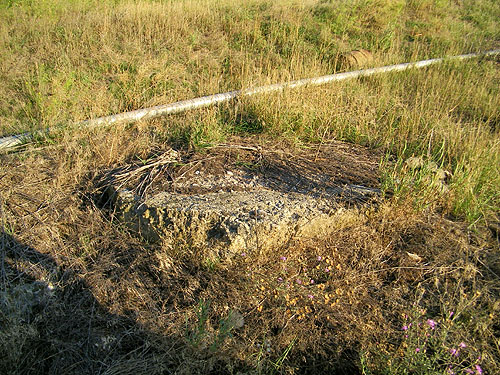 |
| 18: We
located a large number of large sections of concrete. |
| |
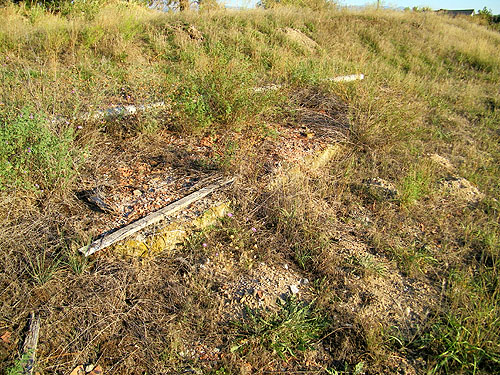 |
| 19: This
section of concrete, just in front of the 2x4 was almost
completely buried. |
| |
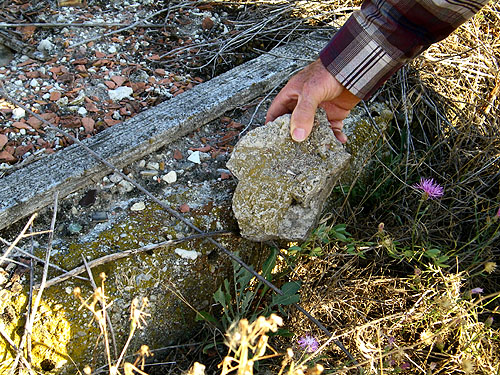 |
| 20: John
hold a small piece of concrete next to a section of
concrete, an artifact of the Bitter Root Inn to be added to
our collection. |
| |
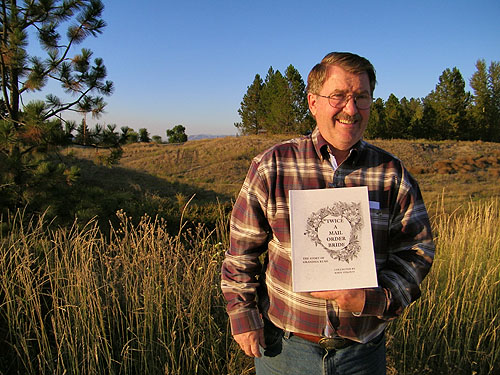 |
21: John
Stroud hold a copy of his book "Twice a Mail Order Bride" which
includes information and three photographic postcards of the
Bitter Root Inn. The site is over his left shoulder, across
the ravine.
For more information about John's book... |
|
|
|
|
|
|
|
Additional Biographical Information and Reading |
|
|
| |
|
|
 |
|
The Iron and Steel Works of The United
States, 1904
Compiled and Published by The American Iron & Steel
Association, Philadelphia, PA. Sixteenth Edition, Printed by Allen, Lane
& Scott, Philadelphia
Includes information concerning W. I. Moody, General Manager
of the Muncie Works, American Rolling Mill Corporation, with offices in
the Rookery Building (S.113), Chicago, Ill. Moody was
involved in financing and promoting the Como Orchard Summer Colony,
University Heights (S.144) and the Bitter Root Inn (S.145).
Pp 468 |
| |
|
|
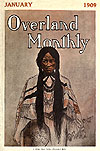 |
|
Overland Monthly
- January 1909
Published monthly by The Overland Monthly Company,
San Francisco, CA and Butte, Montana
By George M. Teale
"The Bitter Root Valley." Description and information on the
Bitter Root Valley. Includes 22 photographs. Includes
information on the Bitter Root Valley Irrigation Co. and W.I.
Moody. "...and some day the inhabitants will look back to
these days and bless the day that the B. R. V. I. Co. was
organized." Moody was
involved in financing and promoting the Como Orchard Summer Colony,
University Heights (S.144) and the Bitter Root Inn (S.145). |
| |
|
|
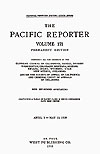 |
|
The Pacific
Reporter, Volume 171 - 1918
Published by West Publishing Co., St. Paul.
"Como Orchard Land Co. v. Markham." Pages 274-276. 6.25 x
10.
Relates to the Como Orchard Summer Colony, University
Heights (S.144) and the Bitter Root Inn (S.145).
Pp 1183 |
| |
|
|
| |
|
|
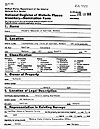 |
|
National
Register of Historic Places, Hamilton, Montana. 1988
Published by the United States Department of the
Interior, National Park Service,
Washington D.C.
Michels, Kirk
History of Hamilton, Montana and the surrounding area.
Includes historical information on the Big Ditch
Development, the Bitterroot District Irrigation Co., and the
two planned communities designed by Frank Lloyd Wright,
which included "University Heights near Darby and the town
of Bitterroot near Corvallis."
Pp 21 |
|
|
|
|
 |
|
National Register of
Historic Places, Stevensville, Montana. 1991
Published by the United States Department of the Interior,
National Park Service Washington D.C.
Montana State
Historical Preservation Office Staff
Multiple Property
Documentation Form. History of Stevensville, Montana and the surrounding
area. Includes historical information on the "Apple Boom", the Big Ditch
Development and the Bitterroot District Irrigation Co. "The new townsite
of Bitterroot was platted just north of Stevensville, and
the Bitterroot Inn, designed by Frank Lloyd Wright, was
built in 1920 and served as an informal headquarters for the
Chicago-based land developers and investors."
Pp 30 |
|
|
|
|
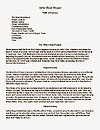 |
|
Bitter
Root Project 1991
Bridges, Kelly
"Thousands of acres of newly irrigable land were purchased
by newcomers. These newly settled lands became the
subdivisions of East Side Addition, Hamilton Heights, ...
and University Heights. Each of these divisions saw the
construction of golf courses and large inns. Additionally,
many of these divisions planted acres of McIntosh Apple
orchards. Intense advertising to attract even more people to
these lands occurred, boasting that land selling from $200
to $300 per acre could earn net returns of $5000 for each
ten acre plot.
Pp 13 |
|
|
|
|
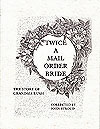 |
|
Twice a
Mail Order Bride, The Story of Grandma Rush,
2006
Published by Stoneydale Press Publishing Company,
Stevensville, MT
Stroud, John
"This Local History also touches on.. the connection of the
Apple Boom to the Bitter Root Inn designed by Frank Lloyd
Wright; as well as the irrigation from Lake Como south of
Hamilton. Lake Como was named by Father Antonio Ravalli
after a lake very similar to this in the Alps of his native
Italy." (Publishers description.) Includes information and
three images of the Bitter Root Inn designed by Frank Lloyd
Wright.
Pp 104 |
|
|
|
|
|
|
|
|
|
|

PROCEEDS FROM EVERY SALE GOES TO SUPPORT THE WRIGHT LIBRARY.




















































